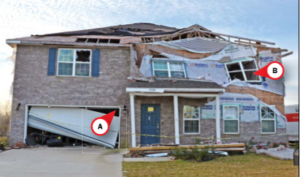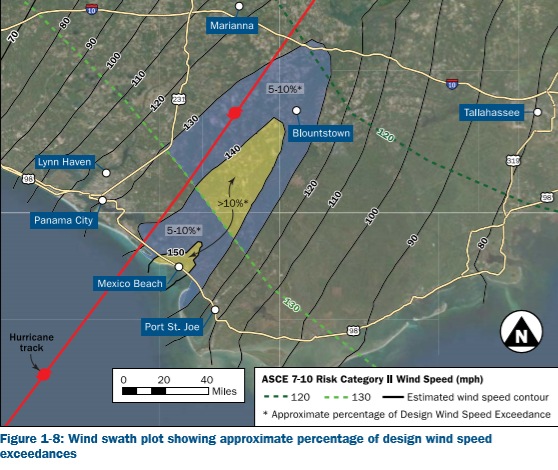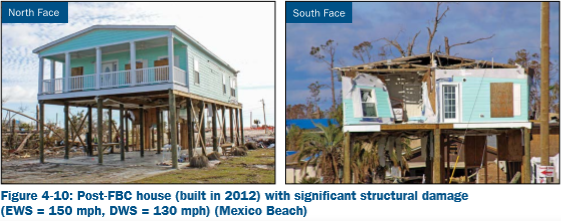FEMA report aims to improve resiliency

Post-Florida Building Code house in Panama City (built in 2016) with significant structural damage {Estimated Wind Speed (EWS) = 127 mph, Design Wind Speed (DWS) = 133 mph}. From FEMA MAT Report
A new FEMA report that analyzed buildings damaged from 2018’s Hurricane Michael in the Florida Panhandle found that in-progress inspections of building envelope components – not just in the Panhandle but throughout Florida – were inconsistently performed. It also found floodplain management requirements were inconsistently enforced.
FEMA’s Building Science Branch deployed a Mitigation Assessment Team (MAT) to a six-county area after Hurricane Michael’s October 2018 landfall. It included members of the state emergency management division and global infrastructure firm AECOM. Their Mitigation Assessment Team Report: Hurricane Michael in Florida assessed the performance of hundreds of varying types of buildings subject to Hurricane Michael’s Cat-5 161 mph winds and upwards of 19-foot flood surge. The MAT assessed coastal and inland residential properties, critical facilities, municipal and public buildings, seawalls, as well as hurricane evacuation shelters.
The report has 69 specific recommendations covering wind and water, but its general conclusions and recommendations were summarized in just two points:
- Floodplain management requirements were inconsistently enforced. The Florida Department of Emergency Management should consider developing/modifying training on the flood provisions in the Florida Building Code (FBC) and local floodplain management ordinances. The Building Officials Association of Florida (BOAF) and other stakeholders should consider developing additional training on roles and responsibilities for communities contracting building department services to a private company.
- In-progress inspections of building envelope components throughout Florida were inconsistently performed. Local jurisdictions should make building envelope inspections a priority. BOAF, the Florida Home Builders Association, and other stakeholders should consider developing training and creating a culture of emphasis on building envelope systems.
 Also noteworthy: Hurricane Michael produced wind speeds above design levels required in the Florida Building code wind standards in certain areas of the Florida Panhandle. It recommends the wind engineering research community perform a revised analysis of the ASCE 7 basic wind speed maps for the Florida Panhandle region to include Michael data. We explored some of the preliminary findings at the time last summer in our Florida Insurance Roundup podcasts, Is Florida’s Building Code Protecting All of Us? and Why the Panhandle Wasn’t Hurricane Strong for Michael. The report also found that testing standards for door and window assemblies did not appear to adequately help prevent water infiltration.
Also noteworthy: Hurricane Michael produced wind speeds above design levels required in the Florida Building code wind standards in certain areas of the Florida Panhandle. It recommends the wind engineering research community perform a revised analysis of the ASCE 7 basic wind speed maps for the Florida Panhandle region to include Michael data. We explored some of the preliminary findings at the time last summer in our Florida Insurance Roundup podcasts, Is Florida’s Building Code Protecting All of Us? and Why the Panhandle Wasn’t Hurricane Strong for Michael. The report also found that testing standards for door and window assemblies did not appear to adequately help prevent water infiltration.
The report’s overall conclusions and recommendations echo those in two FEMA Recovery Advisories that we reported in an LMA Newsletter article “Pitfalls in Mitigating Hurricane Risk” last August. FEMA found that overall, newer construction generally sustained much less damage than older construction, although building envelope damage was also widely observed on newer construction. This envelope damage allowed wind-driven rain to penetrate to the interior, resulting in costly damage. A bill filed in the Florida Legislature this session that would require the entire envelope of certain buildings be impact- and wind-resistant, did not receive a hearing.
The report said best practices, especially with water intrusion, would further mitigate damage. Also, building codes must be properly enforced and implemented to perform as intended. It recommends vulnerability assessments should be performed for critical facilities, at a minimum, noting gaps in education and practice. It also reminds readers that a retrofit to protect a single building element is typically not effective in protecting the entire building.

FEMA said the MAT report’s recommended actions can be taken by FEMA, Federal, State, and local governments; designers, developers, contractors, the construction industry; building code and standards organizations, researchers, planners, emergency managers, building owners and operators and other key stakeholders. When implemented, the report said these recommendations will help to reduce injuries, mitigate damage to buildings and their associated utility systems, and improve building and community resilience from future natural hazard events in Florida and elsewhere.
There’s a lot to read and digest in this 314-page report, including some fascinating pictures showing the impacts of surge, wind, and erosion.
LMA Newsletter of 3-2-20

